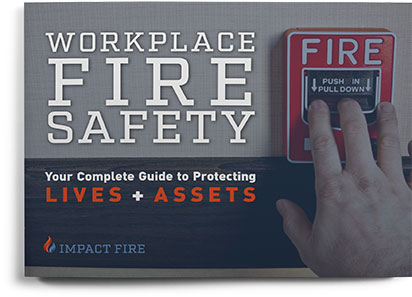More importantly—if you had to use a fire extinguisher, would you know how?
Surprisingly, most people are not able to answer those questions. There's too much at risk to not have a transparent, compliant, and proactive workplace fire safety plan in place to save lives and protect business assets.

Not a problem! Enter your email below for a downloadable PDF version that you can get to on your own time.
Impact Fire will use your email to send you the PDF guide you've requested, as well as information about Impact Fire products and services that may be of interest to you. You can unsubscribe at any time.
There are over 70,000 severe workplace fires annually in the U.S., and over 85% of the resulting damage—whether to property, business assets, or people—is due to human behavior. That means workplace fires are preventable with a proactive fire safety plan.
With proper planning and training, you can empower your employees to quickly make the right decisions to prevent and respond to fires at work. By reviewing your company’s fire safety plan with each employee, you’re helping to save lives, protect valuable business assets, and prevent fire from taking it all away.
While equipment such as fire sprinklers and emergency lights are standard for any public building, each business has unique requirements—not only for code compliance but for true safety. To ensure that your company’s property, business assets, and employees are completely protected with the necessary equipment, the first step in your workplace fire safety plan is to complete a fire hazard assessment.
A fire hazard assessment is an opportunity for fire protection professionals to walk through your facility and make specific recommendations about how you can better protect your business and your employees. Some fire protection companies will sell you the equipment you ask for. However, a genuinely effective fire protection strategy starts by looking for hazards. No recommendations should be provided until a professional has seen your building’s layout, occupancy, and special hazards.
The assessor first talks to the building owner, business owner, facility manager, or other decision-makers about the needs, concerns, and challenges relating to fire protection—does your company deal with any hazardous materials? Do you have any process control rooms, electrical control cabinets, IT/server rooms, or other special hazards that need a particular focus?
After talking through your business’s specific needs, the assessor completes a walkthrough of the facility to identify areas that are not up to code, inadequately protected areas, and any additional fire risks.
Your business is presented with complete recommendations for upgrading or supplementing its fire protection equipment based on the assessor’s findings from the walkthrough. The proposals take into account current best practices and the specific needs of your building and business.
While fire protection equipment is critical to the safety of any building, fire causes the most damage as a result of human behavior. The following sections discuss how to train your employees to respond in case of a fire in the workplace.
To most businesses, it is common knowledge that employers need to provide portable fire extinguishers, keep them accessible, maintain them so that they are fully charged and pressurized, and regularly inspect them, so they’re fully operable and compliant at all times. Many people miss that when extinguishers are provided in a workplace setting, OSHA requires employees to be trained once a year in their use.
Here are the OSHA guidelines that specify the need for employee fire extinguisher training:
Most business owners understand that they must have fire extinguishers in the building legally. But many companies create policies forbidding the use of those extinguishers for their employees, figuring that the company evacuation plan is enough. Unfortunately for them, those policies will never hold up. If an employee chooses to discharge an extinguisher in the face of a fire, it is her choice to defend herself—not the company. The lives of your employees are worth more than a policy. Empower your employees to make their own decision whether to fight the fire or to get themselves out.
For some reason, the word "training" has a negative connotation to many people. They equate it to training a pet and don't see it as something we should be doing for our employees. Instead, many people prefer to implement "education and awareness" initiatives. However, there is a significant difference between education and training.
Military personnel, professional athletes, police officers—they are trained in their jobs to keep themselves and their teammates safe. Similarly, our employees should not simply be educated about fire in the workplace; they should be trained to protect themselves.
Here are the three most important things employees need to know about responding to fires in the workplace:
An incipient stage fire is the first of four stages of fire: incipient, growth, fully developed, and decay. Incipient stage fires have just ignited and can be extinguished with a portable fire extinguisher. Recognizing a fire in this stage provides the best chance at suppression or escape.
Remember, the best way to prevent fires that cause damage to lives and property is to change human behavior. We can install the most advanced fire protection equipment available, but our first line of defense is always our behavior. Empower yourself and your employees to make the right decision.
© Impact Fire Services, LLC | All rights reserved
© 2026 IMPACT FIRE SERVICES, LLC
All Rights Reserved